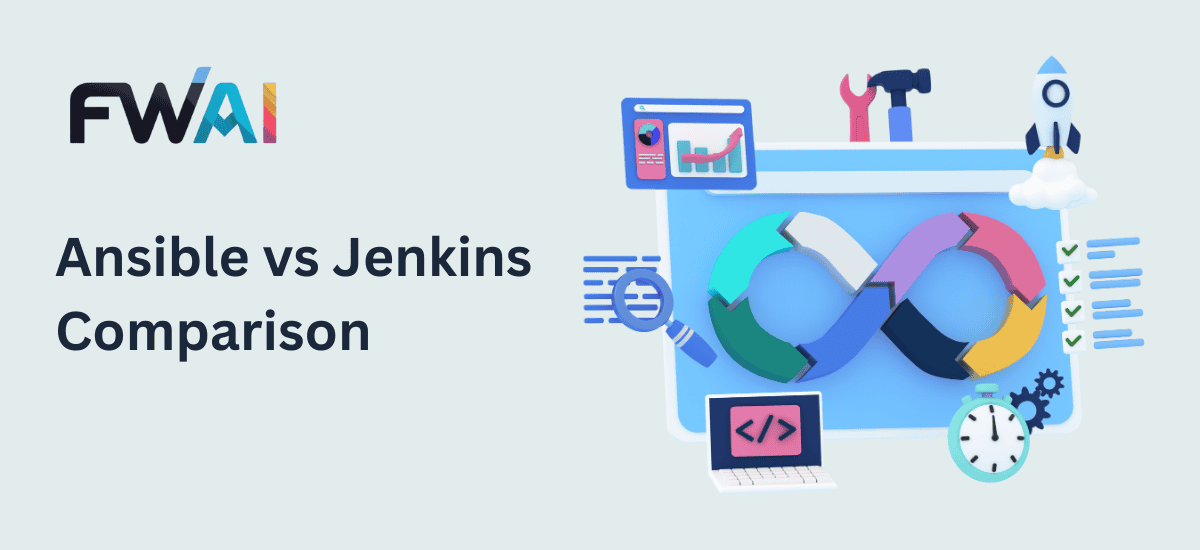
Ansible vs Jenkins: A Comprehensive Comparison
In the realm of DevOps and Continuous Integration/Continuous Deployment (CI/CD), two tools frequently come into the spotlight: Ansible and Jenkins. Both tools serve distinct purposes but are often compared due to their overlapping functionalities and capabilities. This article delves deep into each tool, analyzing their advantages, disadvantages, and features while providing a comparative overview to help you make an informed decision for your development needs.

Understanding Ansible : What is Ansible?
Ansible is an open-source automation tool primarily used for configuration management, application deployment, and task automation. Developed by Red Hat, it operates on a simple architecture that uses a push mechanism to deploy applications and manage systems without requiring agents on the nodes.
Advantages of Ansible
1. Ansible uses YAML (Yet Another Markup Language) for its playbooks, making it easy to read and write. This simplicity allows developers and system administrators to quickly adopt the tool without extensive training.
2. Ansible does not require any agents or daemons on the target machines. This not only simplifies the setup but also reduces overhead and potential points of failure.
3. Ansible ensures that operations can be repeated without causing unintended changes, which is crucial for maintaining system stability.
4. Ansible comes with a rich set of modules that allow for the automation of various tasks, from cloud provisioning to network configuration.
Disadvantages of Ansible
1. In scenarios where a large number of nodes need to be managed simultaneously, Ansible may face performance issues due to its push-based architecture.
2. While Ansible has a web-based interface called Ansible Tower, it is not as feature-rich as some other automation tools. This can be a drawback for users who prefer graphical interfaces.
3. Though YAML is simple, mastering Ansible’s full capabilities, including playbooks and roles, can take time and practice.
Features of Ansible
1. These are the heart of Ansible’s automation, defining the tasks to be executed on the managed nodes.
2. Ansible allows users to define groups of hosts and manage them effectively.
3. Being open-source, Ansible has a large community that contributes to its modules, making it adaptable and versatile.
4. Ansible can easily integrate with various cloud platforms like AWS, Azure, and Google Cloud, streamlining deployments and management.
Understanding Jenkins : What is Jenkins?
Jenkins is an open-source automation server that is primarily used for continuous integration and continuous delivery (CI/CD). It enables developers to automate the building, testing, and deployment of applications, making it a cornerstone of modern software development practices.

Advantages of Jenkins
1. Jenkins boasts a vast library of plugins that extend its functionality, allowing integration with various tools and technologies, including version control systems, build tools, and testing frameworks.
2. With a large user base, Jenkins benefits from a robust community that contributes to its ongoing development and provides a wealth of resources and documentation.
3. Jenkins supports distributed builds, enabling it to scale horizontally by distributing workloads across multiple machines.
4. Jenkins provides a web-based interface that is customizable, allowing users to tailor the dashboard to their needs.
Disadvantages of Jenkins
1. Setting up Jenkins and maintaining it can be complex, especially in larger environments. Users may require a significant amount of time to configure and manage Jenkins effectively.
2. Jenkins can be resource-intensive, particularly when managing multiple jobs and plugins. This may lead to performance bottlenecks if not managed properly.
3. While Jenkins is powerful, its extensive features and options can overwhelm new users, necessitating a learning period before they can utilize it effectively.
Features of Jenkins
1. Jenkins allows users to define build pipelines as code, providing flexibility and version control for CI/CD processes.
2. Jenkins integrates seamlessly with a plethora of tools, including Docker, Kubernetes, and various testing frameworks.
3. Jenkins supports numerous version control systems, including Git, Subversion, and Mercurial, easing the process of continuous integration.
4. Jenkins provides real-time monitoring of build status and logs, enabling developers to catch issues early in the development process.
Ansible vs Jenkins: A Comparative Overview
Ansible vs Jenkins : Which Tool is Best for What Action?
When evaluating Ansible and Jenkins, it is crucial to consider the specific needs of your project or organization. Ansible excels in scenarios where configuration management, application deployment, and automation across diverse environments are paramount. Its agentless architecture and ease of use make it a suitable choice for teams looking to automate routine tasks without the overhead of managing agent installations.
On the other hand, Jenkins is the go-to tool for continuous integration and delivery. Its extensive plugin ecosystem and pipeline capabilities allow for complex build and deployment workflows. Organizations looking to implement CI/CD practices will find Jenkins indispensable for automating their software delivery processes.
Conclusion
In conclusion, both Ansible and Jenkins are powerful tools that serve distinct yet sometimes overlapping purposes in the DevOps landscape. Ansible is ideal for configuration management and automation, while Jenkins shines in CI/CD workflows. The choice between the two ultimately depends on your specific requirements, team expertise, and project goals. By understanding the strengths and weaknesses of each tool, you can make an informed decision that aligns with your development strategy and enhances your operational efficiency.